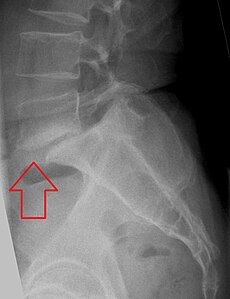

| Spondylolisthesis | |
|---|---|

X-ray of the lateral lumbar spine with a grade III spondylolisthesis at the L5-S1 level.
|
The variant "olisthesis," resulting from division of this compound word, is sometimes applied in conjunction with scoliosis. These "slips" occur most commonly in the lumbar spine. Spondylolysis (a defect or fracture of the pars interarticularis of the vertebral arch) is the most common cause of spondylolisthesis, which should not be confused with a spinal disc herniation (often misleadingly referred to as a "slipped disc"), in which one of the spinal discs in between the vertebrae has ruptured.
A hangman's fracture is a specific type of spondylolisthesis where the second cervical vertebra (C2) is displaced anteriorly relative to the C3 vertebra due to fractures of the C2 vertebra's pedicles.
Top of page
Classification
Spondylolisthesis is categorized into five types:
A: pars fatigue fracture
B: pars elongation due to multiple healed stress fx
C: pars acute fracture
 |
 |
 |
| X-ray picture of a grade 1 isthmic spondylolisthesis at L4-5 |
MRI of L5-S1 spondylolisthesis |
X-ray of a grade 4 |
Top of page
Signs and symptoms
Symptoms of spondylolisthesis include:
- A general stiffening of the back and a tightening of the hamstrings, with a resulting change in both posture and gait.
- A leaning-forward or semi-kyphotic posture may be seen, due to compensatory changes.
- A "waddle" may be seen in more advanced causes, due to compensatory pelvic rotation due to decreased lumbar spine rotation.
- A result of the change in gait is often a noticeable atrophy in the gluteal muscles due to lack of use.
- Generalized lower-back pain may also be seen, with intermittent shooting pain from the buttocks to the posterior thigh, and/or lower leg via the sciatic nerve.
Other symptoms may include tingling and numbness. Coughing and sneezing can intensify the pain. An individual may also note a "slipping sensation" when moving into an upright position. Sitting and trying to stand up may be painful and difficult.
Top of page
Treatment
Treatment of isthmic spondylolisthesis is controversial.
Conservative management
Patients with symptomatic isthmic spondylolisthesis are initially offered conservative treatment consisting of activity modification, pharmacological intervention, and a physical therapy consultation.
- Physical therapy can evaluate and address postural and compensatory movement abnormalities.
- Anti-inflammatory medications (NSAIDS) in combination with paracetamol (Tylenol) can be tried initially. If a severe radicular component is present, a short course of oral steroids such as Prednisone or Methylprednisolone can be considered. Epidural steroid injections, either interlaminal or transforaminal, performed under fluoroscopic guidance can help with severe radicular (leg) pain. Lumbosacral orthoses may be of benefit for some patients but should be used on a temporary basis to prevent spinal muscle atrophy and loss of proprioception.
Surgical
Degenerative spondylolisthesis with spinal stenosis is one of the most common indications for spine surgery (laminectomy) among older adults.
|
Page Content |


